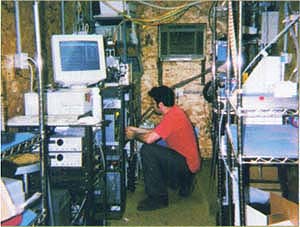All Issues
Super-sensitive nitrogen dioxide detector identifies greenhouse gases
Publication Information
California Agriculture 56(3):85-85.
Published May 01, 2002
PDF | Citation | Permissions
Full text
With the aid of the most sensitive nitrogen dioxide detector in the world, UC Berkeley chemists can now quantify certain important contributors to air pollution and global warming.
Human-made nitrogen oxide compounds are emitted by automobiles, industrial smokestacks and other sources; they react with natural hydrocarbons from vegetation to produce ozone smog. "Ozone in the troposphere has doubled in the past century, contributing 10% to 15% of the human additions to the greenhouse effect," says UC Berkeley chemistry professor Ronald C. Cohen. "All of this is driven by nitrogen oxides."
Doug Day checks the performance of the world's most sensitive nitrogen dioxide detector, in a trailer at the UC Blodgett Forest Research Center in El Dorado County. The detector found high levels of previously unquantified organic nitrogen compounds, an observation that current models cannot adequately explain.
Until now, however, as much as half the resulting nitrogen oxides have been unaccounted for in the atmosphere, leaving air pollution models incomplete. Today's smog monitors measure essentially the sum total of all nitrogen oxides in the air, and are unable to break them down into the specific amount of each nitrogen oxide-containing chemical.
Over about 4 years, Cohen and his laboratory colleagues developed a new detector, called thermal dissociation-laser induced fluorescence (TD-LIF), which can monitor nitrogen oxide compounds continuously with sensitivity down to 30 parts per trillion. The technique is a thousand times more sensitive than needed for today's pollution monitoring and sensitive enough for studies in remote locations.
Deploying the detector in downtown Houston and in a remote Sierra Nevada forest, the scientists detected large amounts of organic nitrogen oxide compounds called alkyl nitrates, which were thought to be only a minor constituent of smog.
"If we want to understand quantitatively the effect of local pollution on the global scale, we need to know how and in what form nitrogen oxide is transferred to the rest of the globe," Cohen says.
The research was published in the March 2002 issue of the Journal of Geophysical Research-Atmospheres, and is supported by the National Aeronautics and Space Administration.
— Compiled from UC and other news sources





